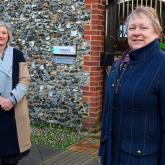A SUPPLY/DEMAND MISMATCH OFFERING OPPORTUNITIES FOR THE INVESTOR
Published 24 February 2021
 It is a basic tenet of economics that where there is a mismatch between supply and demand, a business opportunity exists – and that is certainly the case when it comes to industrial property.
It is a basic tenet of economics that where there is a mismatch between supply and demand, a business opportunity exists – and that is certainly the case when it comes to industrial property.
Whilst bricks and mortar retail emerges slightly battered from the past 12 months, and with the complexion of the office market likely to change (although predictions of the death of the office are very wide of the mark), demand for industrial buildings is soaring, at a time when there is a scarcity of supply.
That demand is right across the spectrum, from 1,500 sq ft units right up to 75,000 sq ft and beyond – we have had significant interest in a 90,000 sq ft storage and distribution warehouse on which we were recently instructed. While the big units are certainly being snapped up, the sweet spot for demand is at the sub 3,000 sq ft.
This demand is principally being driven by a voracious appetite for warehousing and distribution space, as Covid-19 accelerates the move towards online shopping. In addition, continuing uncertainty about supply post-Brexit is causing manufacturers to hold bigger inventories, and that needs storage space as well.
With the cost of borrowing so low – and increased demand driving up rents, we are seeing a big increase in the number of occupiers opting to buy freehold; given that the cost of servicing a mortgage is likely to be less than that of renting a building, it’s not hard to see why. But this trend in turn is hoovering up much of the supply, leading to a shortage of leasehold properties – which in turns is driving up rents even more.
Uncertainty over Brexit in 2019, immediately followed by the Covid pandemic, means that there has been little speculative development over the past two years. This is likely to change in 2021, but new industrial buildings don’t appear overnight – planning and construction takes 15 months on average, so even a building given the green light today won’t come on stream until mid-2022.
The opportunity in all of this is for the investor, whether in existing building freeholds or in speculative new-build. As ever, location is the key – the main shortages are around Norwich, and along the A11 and A47 corridors. But with rental yields in the region of 6-7 per cent – even allowing for increasing freehold costs – the attractions for investors are obvious.
The flip-side, of course, is that occupiers looking for leasehold property are going to find themselves paying more than they were 12 months ago, and may have to look hard for the right premises in the right location. So not everyone is a winner in this supply/demand mismatch – but when it’s this way round, it does at least indicate a fundamental strength in the underlying economy.
Share this story
Arnolds Keys Blog

Roadmap out of lockdown - business changes
22 February 2021
With the announcement of the roadmap out of lockdown Jan Hytch answers some questions about what that means for Arnolds Keys. Read more >

WHY THE CHANCELLOR SHOULD BUDGET FOR A STAMP DUTY HOLIDAY EXTENSION
19 February 2021
Rishi Sunak is probably one of the few politicians whose reputation has not been tarnished by the Covid crisis. Read more >

NORWICH’S ESTATE AGENTS SHOW SUPPORT FOR CITY’S HOMELESS
17 February 2021
Estate agents in and around Norwich have shown their support for people who don’t have a home, by making a £1,500 donation to a city-based charity which helps the homeless. Read more >

The kitchen is the heart of the home
14 February 2021
Whether it’s baking bread, kids’ cookery classes as part of home-schooling, or just trying to keep lockdown spirits up with home-cooked comfort food, the kitchen has increasingly become the centre... Read more >
